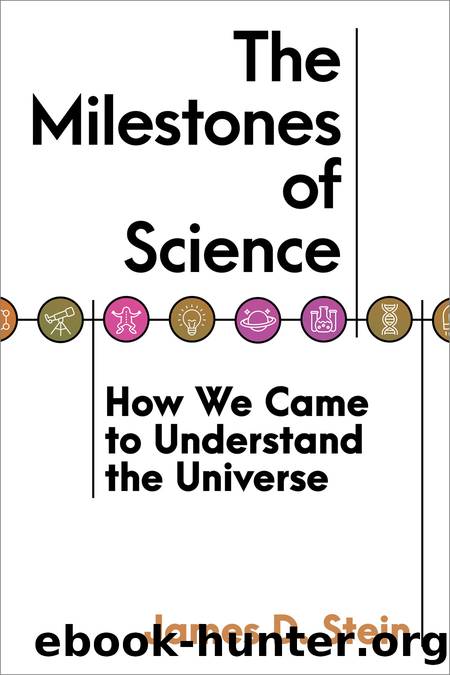The Milestones of Science by James D. Stein

Author:James D. Stein
Language: eng
Format: epub
Publisher: Prometheus
Published: 2022-10-29T00:00:00+00:00
QUARKS
Science sometimes appears to be an endless series of revelations, as prevailing explanations are succeeded by new ones. Often this is the result of a three-step procedure of collecting data, organizing the data into a pattern, and constructing a theory that explains the reason for the pattern. Examples of this from chemistry would be the search for new elements, Mendeleevâs construction of the periodic table, and Bohrâs description of the atom.
Man has been searching for the ultimate constituents of matter since the Greeks first conjectured them to be air, water, earth, and fire. After atoms were revealed to have structure in the first quarter of the twentieth century, it appeared that the question might have been solved: atoms consisted of a cloud of electrons orbiting a nucleus of protons and neutrons. However, it was quickly apparent that this model of matter was incomplete.
In order to probe structure, it is necessary to use more and more energy the deeper one goes. To pry electrons away from an atom does not require much energy; this is the level at which ordinary chemical reactions take place. To break up the nucleus requires substantially more energy. By the middle of the century, particle accelerators capable of delivering ever greater amounts of energy had been built for precisely this purpose.
The results were fascinating from an experimental standpoint but disturbing from a theoretical one. More than a hundred different particles were found, a virtual âzooâ waiting for a modern Mendeleev to come along and organize them. In the early 1960s, both Murray Gell-Mann and Yuval Neâeman arrived at an organizational chart called the Eightfold Way. In almost a repeat of the Mendeleev story, there was a gap in the chart that demanded the existence of a particle with specific properties; that particle was quickly discovered. The Eightfold Way was the periodic table of particles, but was there an underlying idea that could explain it?
In the late 1950s, Robert Hofstadter had conducted probes of protons and neutrons at the highest energy levels then available. He discovered that protons and neutrons were not hard, point-like particles, but rather appeared to have some sort of internal structure. This made it appear possible that neutrons and protons could be composite particles themselves.
Gell-Mann and George Zweig, another physicist from Caltech, independently devised a system of particles that would account for this. These particles would combine in sets of three to make protons and neutrons, and other combinations could account for the other particles. Gell-Mann called them âquarks,â based on a line in James Joyceâs Finneganâs Wake, âThree quarks for Muster Mark.â The appellation stuck.
Decades of experimentation have confirmed that there are three families of quarks. The first family, the up and down quarks, make up the protons and neutrons of ordinary matter. The other two families are the charm and strange quark, and the top and bottom quark, and they make up the more exotic particles that are produced in high-energy processes, either by particle accelerators or as cosmic rays. Accompanying the three families of quarks are three families of leptons.
Download
This site does not store any files on its server. We only index and link to content provided by other sites. Please contact the content providers to delete copyright contents if any and email us, we'll remove relevant links or contents immediately.
| Africa | Americas |
| Arctic & Antarctica | Asia |
| Australia & Oceania | Europe |
| Middle East | Russia |
| United States | World |
| Ancient Civilizations | Military |
| Historical Study & Educational Resources |
Cecilia; Or, Memoirs of an Heiress — Volume 1 by Fanny Burney(31348)
Cecilia; Or, Memoirs of an Heiress — Volume 3 by Fanny Burney(30947)
Cecilia; Or, Memoirs of an Heiress — Volume 2 by Fanny Burney(30906)
The Secret History by Donna Tartt(16656)
Sapiens: A Brief History of Humankind by Yuval Noah Harari(13071)
Leonardo da Vinci by Walter Isaacson(11914)
The Radium Girls by Kate Moore(10915)
Sapiens by Yuval Noah Harari(4550)
The Wind in My Hair by Masih Alinejad(4427)
How Democracies Die by Steven Levitsky & Daniel Ziblatt(4409)
Homo Deus: A Brief History of Tomorrow by Yuval Noah Harari(4288)
Endurance: Shackleton's Incredible Voyage by Alfred Lansing(3854)
The Silk Roads by Peter Frankopan(3777)
Man's Search for Meaning by Viktor Frankl(3646)
Millionaire: The Philanderer, Gambler, and Duelist Who Invented Modern Finance by Janet Gleeson(3575)
The Rape of Nanking by Iris Chang(3526)
Hitler in Los Angeles by Steven J. Ross(3446)
The Motorcycle Diaries by Ernesto Che Guevara(3343)
Joan of Arc by Mary Gordon(3268)
